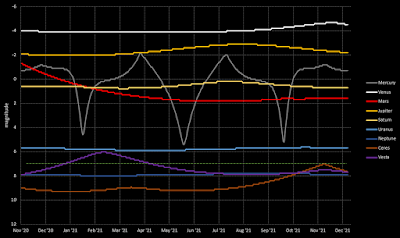Added in a couple of asteroids (dwarf planets, minor planets, whatever) that dance around the brightness of Neptune.
Data from SkyTools 3 Pro ephemerides. Composted in Excel.
Venus (the white line) climbs to almost -5 next fall. Looks like Jupiter (orange) opposition is around August 2021. Mars (red) is fading, fading, fading away. Look at that weird symmetrical pattern with (grey) Mercury! The green dashed line is the human vision threshold.
There ya go! Vesta (purple) climbs into naked eye range in Q1 2021. Whereas Ceres (brown) is never visible to the Mark I eyeball.
This ties back to my post "how many planets can you see?" made on 19 Nov.
I had a "it's in the handbook" moment today so I skimmed the RASC 2020 Observer's Handbook. I thought there WAS a graph like what I've done for all the planets for the whole year but I didn't see it... I was sure that was a feature. Maybe I missed it.
§
Found it! Page 96 of the 2020 edition...
Ah. They do not include the outer ice giants nor minor planets. Their chart goes to mag +2 and a bit.
It'll be fun to compare mine above to the 2021 RASC chart...
§
Check out the freaky graph by Mallama and Hilton on the Sky & Tel measuring planet magnitudes page...
§
https://skyandtelescope.org/observing/measuring-planet-magnitudes/
Would help if I included the link... Click away!



No comments:
Post a Comment